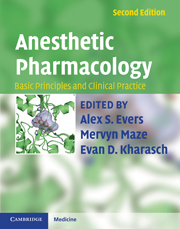15 results
20 - Pain and Anesthesia
- from II - Therapeutic Areas
-
-
- Book:
- Principles of Pharmacogenetics and Pharmacogenomics
- Published online:
- 05 June 2012
- Print publication:
- 23 January 2012, pp 224-237
-
- Chapter
- Export citation
Section 4 - Clinical applications: evidence-based anesthesia practice
-
- Book:
- Anesthetic Pharmacology
- Published online:
- 11 April 2011
- Print publication:
- 10 March 2011, pp 987-1006
-
- Chapter
- Export citation
Anesthetic Pharmacology - Half title page
-
- Book:
- Anesthetic Pharmacology
- Published online:
- 11 April 2011
- Print publication:
- 10 March 2011, pp i-ii
-
- Chapter
- Export citation
Contributors
-
-
- Book:
- Anesthetic Pharmacology
- Published online:
- 11 April 2011
- Print publication:
- 10 March 2011, pp viii-xiv
-
- Chapter
- Export citation
Section 2 - Physiologic substrates of drug action
-
- Book:
- Anesthetic Pharmacology
- Published online:
- 11 April 2011
- Print publication:
- 10 March 2011, pp 177-191
-
- Chapter
- Export citation
Contents
-
- Book:
- Anesthetic Pharmacology
- Published online:
- 11 April 2011
- Print publication:
- 10 March 2011, pp v-vii
-
- Chapter
- Export citation
Preface
-
- Book:
- Anesthetic Pharmacology
- Published online:
- 11 April 2011
- Print publication:
- 10 March 2011, pp xv-xvi
-
- Chapter
- Export citation
Section 1 - Principles of drug action
-
- Book:
- Anesthetic Pharmacology
- Published online:
- 11 April 2011
- Print publication:
- 10 March 2011, pp 1-16
-
- Chapter
- Export citation
Anesthetic Pharmacology - Title page
-
-
- Book:
- Anesthetic Pharmacology
- Published online:
- 11 April 2011
- Print publication:
- 10 March 2011, pp iii-iii
-
- Chapter
- Export citation
Section 3 - Essential drugs in anesthetic practice
-
- Book:
- Anesthetic Pharmacology
- Published online:
- 11 April 2011
- Print publication:
- 10 March 2011, pp 359-384
-
- Chapter
- Export citation
Copyright page
-
- Book:
- Anesthetic Pharmacology
- Published online:
- 11 April 2011
- Print publication:
- 10 March 2011, pp iv-iv
-
- Chapter
- Export citation
Index
-
- Book:
- Anesthetic Pharmacology
- Published online:
- 11 April 2011
- Print publication:
- 10 March 2011, pp 1163-1194
-
- Chapter
- Export citation
Chapter 6 - Principles of drug biotransformation
-
-
- Book:
- Anesthetic Pharmacology
- Published online:
- 11 April 2011
- Print publication:
- 10 March 2011, pp 72-89
-
- Chapter
- Export citation
Chapter 7 - Drug transport and transporters
-
-
- Book:
- Anesthetic Pharmacology
- Published online:
- 11 April 2011
- Print publication:
- 10 March 2011, pp 90-102
-
- Chapter
- Export citation

Anesthetic Pharmacology
- Basic Principles and Clinical Practice
-
- Published online:
- 11 April 2011
- Print publication:
- 10 March 2011



